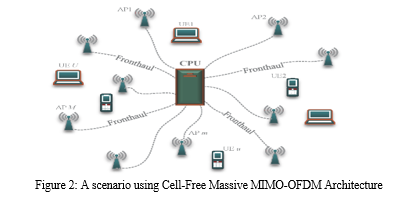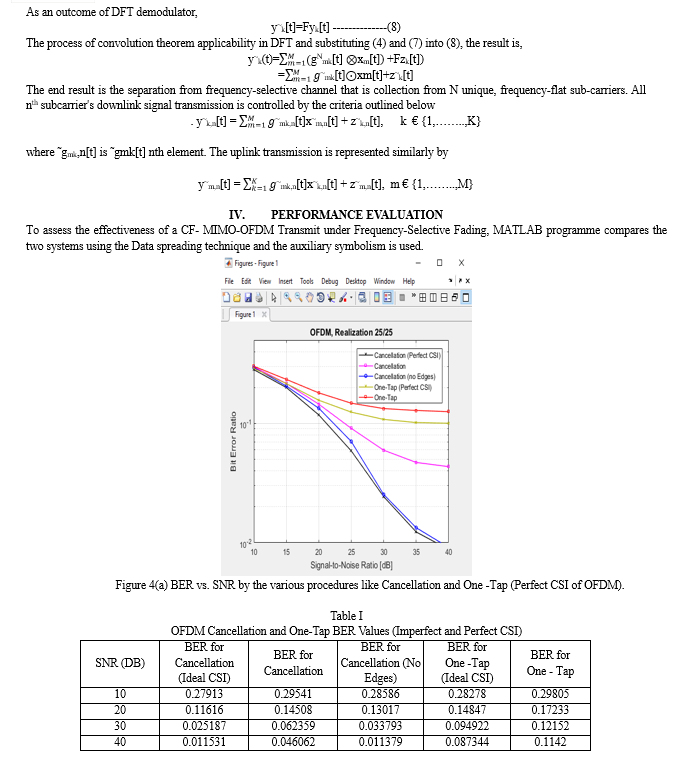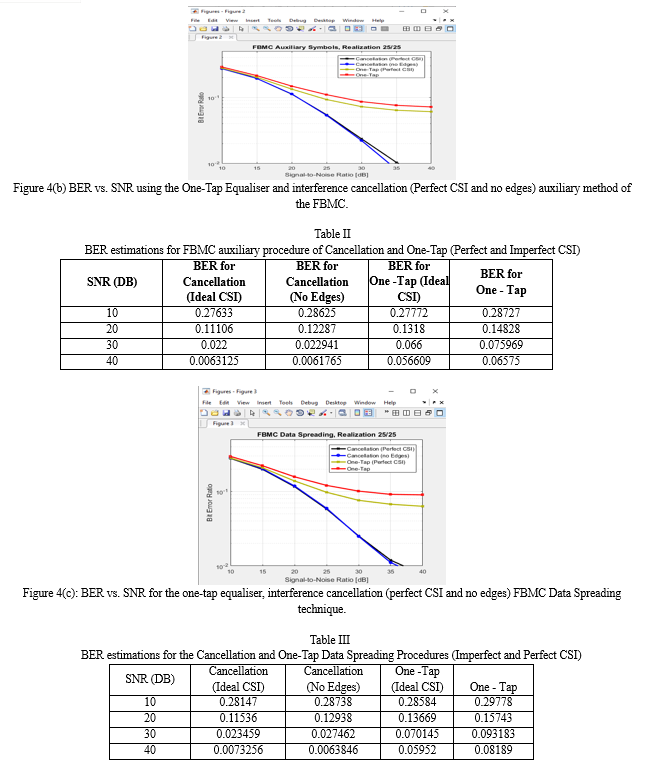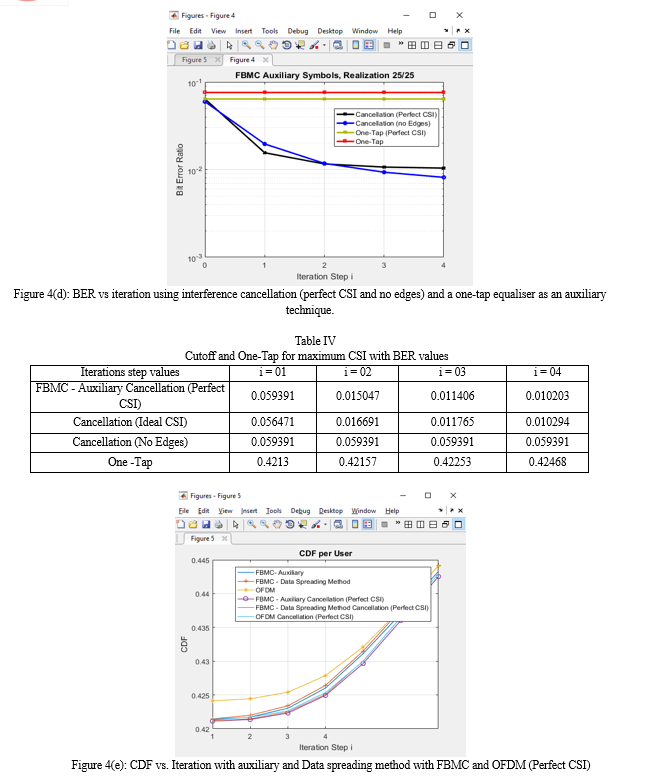Ijraset Journal For Research in Applied Science and Engineering Technology
- Home / Ijraset
- On This Page
- Abstract
- Introduction
- Conclusion
- References
- Copyright
Massive MIMO-OFDM Transmission Without Cellular Networks Using Frequency - Selective Fading Channels
Authors: Dr. M. VijayaLakshmi, C. Anisha
DOI Link: https://doi.org/10.22214/ijraset.2023.56225
Certificate: View Certificate
Abstract
For cell-free massive multi-input multi-output (CF-m-MIMO) across frequency-selective fading channels, this system introduces and determines the effectiveness of the orthogonal frequency-division multiplexing (OFDM)-based multi-carrier transmission. The CF-m-MIMO-OFDM system can accommodate a substantial user base and is flexible enough to offer a range of data rates for usage in a variety of contexts. With its scalability and flexibility, the CF-m-MIMO-OFDM transmission network can serve a large number of users at variable data rates. It is proposed to beamform in the frequency-domain conjugate, to choose a pilot, and to allocate resources differently for each user. User-specific resource allocation, pilot selection, and frequency-domain conjugate beamforming are all suggested. The CF-m-MIMO-OFDM system can support a large number of users and can offer varying data rates to accommodate a wide range of applications.
Introduction
I. INTRODUCTION
Recently, researchers and industry have shown an interest in Cell-free Massive MIMO (CF-m-MIMO). Resource distribution [2], management of power [3], pilot assignment [4], efficiency of energy [5], backhaul limitations [6], and sustainability [7] are some of the various CF-m-MIMO issues that are addressed. The majority of modern wireless communications are broadband because of frequency selectivity, which means that the bandwidth of the signal is substantially bigger than the coherent frequency. The discussion in the present research is exclusive to CF-m-MIMO across frequency-selective fading channel. However, because it relied on absurdly complex signal equalisation, it was unable to accommodate high data speeds via single carrier transmission.
Traditional CF-m-MIMO systems also make an effort to offer dependable service by limiting the power allotted to each user, despite the fact that different users have different bandwidth requirements. Uplink uses a time-frequency grid for contamination-free pilot assignment and channel estimation while downlink uses frequency-domain conjugate beamforming to deliver data. In order to scale to a high number of users [3] and provide various data rates, the approach of user-specific resource allocation is offered. Take into consideration APs with one or more antennas when evaluating the capacity of the network as a whole and that of each individual user.
Massive MIMO represents a potential 5G wireless access solution that provides connectivity for many devices at the identical time-frequency energy from a single base station with multiple antennas to maximise throughput, reliability, and efficiency while allocating the least amount of signal processing resources [2], energy power control [3].
According to [1], wireless Cell-Free (CF) Massive MIMO network employs a variety for scattered AP’s (access points) to provide service to just a handful of clients all at once using the identical time / frequency resources. A single antenna limits both users and APs. The APs identify the uplink pilot signals from the users using time-division duplexing to determine the channel condition. Performance-wise, Cell-Free Massive MIMO significantly surpasses a conventional minute-cell network where each client gets support with a different AP. The 95%-likely bandwidth per user and the spatial correlation resistance to shadow fading are also illustrations of this [1].
Weighted visual framework as a means of assigning pilots in an effective manner is proposed [2]. First, a unique measure is developed to capture the degree of probable mutual pilot contamination in a topology without cells. The network's dynamic interference connection is then represented by the weighted pilot pollution graph, which is built from this data. Finally, a probing technique is used to accomplish pilot cleanse after mapping the pilot allocation optimisation to the Max k-Cut issue. The suggested technique has been shown to perform better than competing approaches in numerical simulations, and is capable of a substantial throughput gain with a little increase in complexity.
[3] proposes a beamforming method based on the zero-forcing strategy that eliminates the necessity for channel estimation at mobile stations (MS), extending the cell-free (CF) strategy to the case in which both the APs and the MSs have multiple antennas. Contrary to the first suggested formulation, the user-centric (UC) method of cell-free (CF) massive MIMO gives individual mobile stations (MSs') needs the highest priority by using a limited number of access points (APs). The concept of sequential lower bound maximisation is used in this study to propose and examine both uplink and downlink power allocation approaches that maximise sum rate or minimise rate.
II. RELATED WORKS
A. Massive MIMO Systems
A distinguishing feature of Un-cellular Massive MIMO was their operational mode, which employs computationally straightforward (conjugate beamforming) signal processing to distribute an enormous amount in single-antenna access points across a considerably lower amount of individuals at once. Thus, it makes simpler to take advantage of events like strengthening of channels as favourable growth, that have vital elements for cellular Massive MIMO energy efficiency. As a result, it is possible to apply simple schemes for pilot assignment with computationally efficient, worldwide optimal power control computations, as will be demonstrated by the future study. In conclusion, Un-cellular Massive MIMO in a practical as well as scaleable application in network MIMO and DAS principles, just as Cell Massive MIMO provides a practical and scaleable version, initially proposed multiple user MIMO idea.
B. MIMO-OFDM Systems

To improve system efficiency, MIMO and OFDM techniques are integrated. Especially under difficult channel circumstances, MIMO-OFDM is employed to boost channel capacity. In 4G mobile wireless systems, this is acknowledged to be one among the more economical technologies [1]. Spatially multiplexed MIMO has been shown to boost throughput; yet, if greater throughputs are targeted, the MIMO multipath channels' environment become frequency-selective. By converting a MIMO frequency-selective channel onto parallel frequency-flat MIMO channels, OFDM offers the advantage of increasing frequency effectiveness. Due to the incorporation of two technologies, it may include more antennas. Receiver complexity is able to reduce by becoming accustomed to MIMO-OFDM. Many emerging wireless technologies might employ this. Its BER is poor.
Since MIMO fails to reduce multipath propagation and OFDM does not require signal equalisation, the two technologies together have an extremely strong effect. Without channel state information usage (CSI), MIMO-OFDM is still capable of achieving exceptionally high spectral performance. It is feasible to get close to achieving the theoretical channel bandwidth if the transmitter has CSI (that is acquired through the application of instruction sequences). For instance, CSI can be used to utilise the channel for communication as efficiently as feasible by allocating different size signal patterns to different subcarriers.
User-Multiple MIMO (MU-MIMO), more advanced MIMO deployments (more spatial streams), as well as research on enormous MIMO along with cooperative MIMO (CO-MIMO) potential include in upcoming specifications for 5G are latest MIMO-OFDM advances. Its 802.11ac standard, initial Wi-Fi standard for provide rates within gigabit every minute variety, includes MU-MIMO. The access point (AP) may send data to a maximum of four device clients at once through MU-MIMO. With regular channel evaluations needed to correctly route the signals, this avoids congestion delays.
At least four out of the eight possible spatial streams can be utilised by every user. An AP with eight antennas, for instance, may interact through two device clients both containing four antennae and deliver four spatial streams to them. Additionally, a single AP may interact with four client devices that have a pair of antennas all of them giving every one of them access to two spatial streams.
Only individual spatial stream systems benefit from multiple users MIMO beamforming. A multi-client communication access point only had the capacity to transmit to one device at once before beamforming with MU-MIMO. A point of access can send data upto a maximum of quadrilateral single stream devices simultaneously using MU-MIMO beamforming on a single channel.
Additionally, the 802.11ac specification offers single-user speeds of as high as 6.93 Gbit/s utilising octagon spatial streams. The highest data rate is predicated upon the utilisation of 256 QAM (quadrature amplitude modulation) with the 5 GHz band's optional 160 MHz channel. Chipsets that support six streams of space were released, while chipsets that enable eight spatial streams are being prepared.
The use of a Massive MIMO system is enormous amount of base station antennas with a setting for MU-MIMO. The capacity of particularly mono spatial stream handsets can be greatly increased via massive MIMO, despite the fact that LTE networks already allow phones to have dual spatial streams and different handset antenna configurations able in handling quadruple spatial streams are being evaluated. MU-MIMO beamforming is applied again for the base station to cater for multiple handsets with distinct information streams simultaneously on a same channel. The issue is an aspect that has needed to be examined further in order to figure out when it is best to add tiny cells as rather than antennas on the base station.
C. Frequency- Selective fading Channels
The sort underlying fading that a signal experiences when it travels across a mobile radio channel is determined by the properties of the broadcast signal in relation to the channel's parameters. If a transmitted signal's bandwidth surpasses the range of frequencies that a channel that is wireless is capable of keeping an even gain and linear phase, frequency selective fading takes place. In certain circumstances, the multipath delay dispersion exceeds the symbol spacing. As a result, the transmitted waveform is present in numerous attenuated and time-delayed forms in the signal that was received, which causes the received signal to be distorted. As an outcome from the transmitted symbol's time dispersion inside the channel's bandwidth, frequency selective fading occurs.
Inter symbol Interference (ISI) is the effect of the sign spreading outwards over time. It can be seen that distinct components acquire varying gains from one another in the domain of frequency. In transmitted signal's wavelength possesses a wider bandwidth compared to the channel's coherence bandwidth in the instance with frequency selective fading. Wideband channels were another name for frequency selective fading channels because they have a symbol bandwidth that is larger compared to the coherence bandwidth. Multipath fading is referred to as selective fading or selective frequency fading whenever its chosen frequency component is impacted. It denotes that certain frequency components of an identical signal will exhibit higher error as well as attenuation than other elements of frequency.
III. METHODOLOGY
A. Massive MIMO system without Cells
Consider the situation depicted in Fig. 1, where M evenly spaced AP’s (access points) vary by distance within CPU will supply K by means of a fronthaul link with randomly distributed clients. Even while they initially operate under the practical assumption that each AP and user only has one antenna, they show how it may be adapted to APs with many antennas. While CF-m-MIMO in its traditional form requires K<< M, CF-m-MIMO-OFDM allows for a wide range of user counts, from an enormous K >> M to a modest K << M. Each user group is given access to a predetermined number of resource blocks (RBs), and new user groups are created. Despite this, every RB meets the requirement that M has far more users than it does.






Conclusion
Using frequency-domain orthogonal pilots, the proposed CF-M-MIMO-OFDM system successfully counters frequency selectivity and eliminates pilot contamination. This method can handle a high number of users and a wide range of service requirements, in contrast to CF-M-MIMO, which can only handle a small number of users with consistent service quality. The utilization in Cell-Free Massive MIMO-OFDM at data rates between tens of kilobytes per second and tens of megabits per second was confirmed by numerical results to be capable of supporting a wide range of user densities, from a few hundred to several thousand.
References
[1] H. Q. Ngo et al., “Cell-free massive MIMO versus small cells,” IEEE Trans. Wireless Commun., vol. 16, no. 3, pp. 1834–1850, Mar. 2017. [2] W. Zeng et al., “Pilot assignment for cell-free massive MIMO systems using a weighted graphic framework,” IEEE Trans. Veh. Technol., Apr. 2021, doi:10.1109/TVT.2021.3076440. [3] S. Buzzi et al., “User-centric 5G cellular networks: Resource allocation and comparison with the cell-free massive MIMO approach,” IEEE Trans. Wireless Communications, vol. 19, no. 2, pp. 1250–1264, Feb. 2020. [4] H. Masoumi and M. J. Emadi, “Performance analysis of cell-free massive MIMO system with limited fronthaul capacity and hardware impairments,” IEEE Trans. Wireless Communications., vol. 19, no. 2, pp. 1038–1052, Feb. 2020. [5] E. Bj¨ornson and L. Sanguinetti, “Scalable cell-free massive MIMO systems,” IEEE Trans. Communications, vol. 68, no. 7, pp. 4247–4261, Jul. 2020. [6] H. Q. Ngo et al., “On the total energy efficiency of cell-free massive MIMO,” IEEE Trans. Green Communications Network, vol. 2, no. 1, pp. 25–39, Mar. 2018. [7] E. Nayebi et al., “Precoding and power optimization in cell-free massive MIMO systems,” IEEE Trans. Wireless Communications, vol. 16, no. 7, pp. 4445–4459, Jul. 2017. [8] S.-N. Jin, D.-W. Yue, and H. H. Nguyen, “Spectral efficiency of a frequency-selective cell-free massive MIMO system with phase noise,” IEEE Wireless Communications Lett., Dec. 2020. [9] W. Jiang and T. Kaiser, “From OFDM to FBMC: Principles and Comparisons,” in Signal Processing for 5G: Algorithms and Implementations, F. L. Luo and C. Zhang, Eds. United Kindom: John Wiley & Sons and IEEE Press, 2016, ch. 3. [10] W. Jiang et al., “The road towards 6G: A comprehensive survey,” IEEE Open J. Communications Society, vol. 2, pp. 334–366, Feb. 2021. [11] D. Tse and P. Viswanath, Fundamentals of Wireless Communication. Cambridge, UK: Cambridge Univ. Press, 2005, ch. 2. [12] Z. Chen and E. Bj¨ornson, “Channel hardening and favorable propagation in cell-free massive MIMO with stochastic geometry,” IEEE Trans. Communications, vol. 66, no. 11, pp. 5205–5219, Nov. 2018.
Copyright
Copyright © 2023 Dr. M. VijayaLakshmi, C. Anisha . This is an open access article distributed under the Creative Commons Attribution License, which permits unrestricted use, distribution, and reproduction in any medium, provided the original work is properly cited.

Download Paper
Paper Id : IJRASET56225
Publish Date : 2023-10-19
ISSN : 2321-9653
Publisher Name : IJRASET
DOI Link : Click Here
 Submit Paper Online
Submit Paper Online

